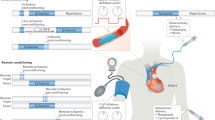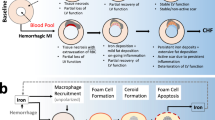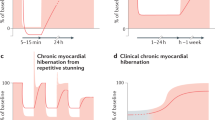Abstract
Animal models of sustained ischemia have shown exacerbation of myocardial injury during reperfusion, mediated largely by cytotoxic effects of free radical generation, complement activation, shifts in substrate use and inflammation. On the basis of current understanding of the pathogenesis of reperfusion injury, numerous therapies have shown a reduction in infarct size and improved ventricular function in animal models. Clinical trial experience has, however, so far been disappointing for the use of these therapies in patients with acute myocardial infarction (MI), being associated with no or inconsistent benefit to left-ventricular function, complications of MI or survival. The growing emphasis on early revascularization with primary coronary intervention and stenting in the management acute MI, with the potential for more complete drug delivery to injured myocardium, could provide greater opportunities for pharmacologic cardioprotection as adjunctive therapy in the future.
This is a preview of subscription content, access via your institution
Access options
Subscribe to this journal
Receive 12 print issues and online access
$209.00 per year
only $17.42 per issue
Buy this article
- Purchase on Springer Link
- Instant access to full article PDF
Prices may be subject to local taxes which are calculated during checkout
Similar content being viewed by others
References
Schomig A et al. (2000) Coronary stenting plus platelet glycoprotein IIb/IIIa blockade compared with tissue activator in acute myocardial infarction: Stent versus Thrombolysis for Occluded Coronary Arteries in Patients with Acute Myocardial Infarction Study Investigators. N Engl J Med 343: 385–391
Montalescot G et al. (2001) Platelet glycoprotein IIb/IIIa inhibition with coronary stenting for acute myocardial infarction. N Engl J Med 344: 1895–1903
Schomig A et al. (2003) Therapy-dependent influence of time-to-treatment interval on myocardial salvage in patients with acute myocardial infarction treated with coronary artery stenting or thrombolysis. Circulation 108: 1084–1088
Jennings RB et al. (1990) Development of cell injury in sustained acute ischemia. Circulation 82 (suppl): II2–II12
Neri Serneri GG et al. (2003) Immunomediated and ischemia-independent inflammation of coronary microvessels in unstable angina. Circ Res 92: 1359–1366
Abbate A et al. (2004) Widespread myocardial inflammation and infarct-related artery patency. Circulation 110: 46–50
Frangogiannis NG et al. (2002) The inflammatory response in myocardial infarction. Cardiovasc Res 53: 31–47
Semenza GL (2000) Cellular and molecular dissection of reperfusion injury: ROS within and without. Circ Res 86: 117–118
Rezkalla SH and Kloner RA (2002) No-reflow phenomenon. Circulation 105: 656–662
Bialik S et al. (1999) The mitochondrial apoptotic pathway is activated by serum and glucose deprivation in cardiac myocytes. Circ Res 85: 403–414
Bielawska AE et al. (1997) Ceramide is involved in triggering of cardiomyocyte apoptosis induced by ischemia and reperfusion. Am J Pathol 151: 1257–1263
Krijnen PAJ et al. (2002) Apoptosis in myocardial ischemia and infarction. J Clin Pathol 55: 801–811
Zhao ZQ et al. (2000) Reperfusion induces myocardial apoptotic cell death. Cardiovasc Res 45: 651–660
Saraste A et al. (1997) Apoptosis in human acute myocardial infarction. Circulation 95: 320–323
Olivetti G et al. (1996) Acute myocardial infarction in humans is associated with activation of programmed myocyte cell death in the surviving portion of the heart. J Mol Cell Cardiol 28: 2005–2016
Williams RS and Benjamin IJ (2000) Protective responses in the ischemic myocardium. J Clin Invest 106: 813–818
Murry CE et al. (1986) Preconditioning with ischemia: a delay of lethal cell injury in ischemic myocardium. Circulation 74: 1124–1136
Sasaki N et al. (2000) Activation of mitochondrial ATP-dependent potassium channels by nitric oxide. Circulation 101: 439–445
Jung F et al. (2000) Hypoxic regulation of inducible nitric oxide synthase via hypoxia inducible factor-1 in cardiac myocytes. Circ Res 86: 319–325
Rossig L et al. (1999) Nitric oxide inhibits caspase-3 by S-nitrosation in vivo. J Biol Chem 274: 6823–6826
Moon C et al. (2003) Erythropoietin reduces myocardial infarction and left ventricular decline and left ventricular functional decline after coronary artery ligation in rats. Proc Natl Acad Sci U S A 100: 11612–11617
Parsa CJ et al. (2003) A novel protective effect of erythropoietin in the infarcted heart. J Clin Invest 112: 999–1007
Radford NB et al. (1996) Cardioprotective effects of 70-kDa heat shock protein transgenic mice. Proc Natl Acad Sci U S A 93: 2339–2342
Martin JL et al. (1997) Small heat shock proteins and protection against ischemic injury in cardiac myocytes. Circulation 96: 4343–4348
Marber MS et al. (1993) Cardiac stress protein elevation 24 hours after brief ischemia or heat stress is associated with resistance to myocardial infarction. Circulation 88: 1264–1272
Hoshida S et al. (1993) Sublethal ischemia alters myocardial antioxidant activity in canine heart. Am J Physiol 33: H33–H39
Braunwald E and Kloner RA (1982) The stunned myocardium: prolonged, post-ischemic ventricular dysfunction. Circulation 66: 1146–1149
Charlat ML et al. (1989) Prolonged abnormalities of left ventricular diastolic wall thinning in the 'stunned' myocardium in conscious dogs: time course and relation to systolic dysfunction. J Am Coll Cardiol 13: 185–194
Kloner RA and Jennings RB (2001) Consequences of brief ischemia: Stunning, preconditioning, and their clinical implications. Part 1. Circulation 104: 2981–2989
Bolli R et al. (1989) Direct evidence that oxygen-derived free radicals contribute to postischemic myocardial dysfunction in the intact dog. Proc Natl Acad Sci U S A 86: 4695–4699
Przyklenk K and Kloner RA (1986) Superoxide dismutase plus catalase improve contractile function in the canine model of the 'stunned myocardium'. Circ Res 58: 148–156
Bolli R et al. (2004) Myocardial protection at a crossroads. The need for translation into clinical practice. Circulation 95: 125–134
Kloner RA and Rezkalla SH (2004) Cardiac protection during acute myocardial infarction: Where do we stand in 2004? J Am Coll Cardiol 44: 276–286
Garratt KN et al. (1998) Intravenous adenosine and lidocaine in patients with acute myocardial infarction. Am Heart J 136: 196–204
Mahaffey KW et al. (1999) Adenosine as an adjunct to thrombolytic therapy for acute myocardial infarction: results of a multicenter, randomized, placebo-controlled trial: the Acute Myocardial Infarct STudy of ADenosine (AMISTAD) trial. J Am Coll Cardiol 34: 1711–1720
Quintana M et al. (2003) Left ventricular function and cardiovascular events following adjuvant therapy with adenosine in acute myocardial infarction treated with thrombolysis, results of the ATTenuation by Adenosine of Cardiac Complications (ATTACC) study. Eur J Clin Pharmacol 59: 1–9
Ross A et al. (2002) Acute Myocardial Infarction STudy of ADenosine (AMISTAD II). J Am Coll Cardiol 39 (Suppl 2): 338A
Kopecky SL et al. (2003) A randomized, double-blinded, placebo-controlled, dose-ranging study measuring the effect of an adenosine agonist on infarct size reduction in patients undergoing primary percutaneous transluminal coronary angioplasty: the ADMIRE (AmP579 Delivery for Myocardial Infarction REduction) study. Am Heart J 146: 146–152
Marzilli M et al. (2000) Beneficial effects of intracoronary adenosine as an adjunct to primary angioplasty in acute myocardial infarction. Circulation 101: 2154–2159
Sodi-Pallares D et al. (1962) Effects of an intravenous infusion of a potassium-glucose-insulin solution on the electrocardiographic signs of myocardial infarction. Am J Cardiol 9: 166–181
Fath-Ordoubadi F and Beatt KJ (1997) Glucose-insulin-potassium therapy for treatment of acute myocardial infarction: an overview of randomized placebo-controlled trials. Circulation 96: 1152–1156
Diaz R et al. (1998) Metabolic modulation of acute myocardial infarction. The ECLA Glucose-insulin-potassium pilot trial. Circulation 98: 2227–2234
Van der Horst ICC et al. (2003) Glucose-insulin-potassium infusion in patients treated with primary angioplasty for acute myocardial infarction: the glucose-insulin-potassium study: a randomized trial. J Am Coll Cardiol 42: 784–791
Pache J et al. (2004) A randomized evaluation of the effects of glucose-insulin-potassium infusion on myocardial salvage in patients with acute myocardial infarction treated with reperfusion therapy. Am Heart J 48: G1–G6
Rupprecht H-J et al. (2000) Cardioprotective effects of the Na+/H+ exchange inhibitor cariporide in patients with acute anterior myocardial infarction undergoing direct PTCA. Circulation 101: 2902–2908
Zeymer U et al. (2001) The Na+/H+ exchange inhibitor eniporide as an adjunct to early reperfusion therapy for acute myocardial infarction. Results of the Evaluation of the Safety and Cardioprotective Effects of Eniporide in Acute Myocardial Infarction (ESCAMI) Trial. J Am Coll Cardiol 38: 1644–1650
Sakata Y et al. (1997) Salutory effect of adjunctive intracoronary nicorandil administration on restoration of myocardial blood flow and functional improvement in patients acute myocardial infarction. Am Heart J 133: 616–621
Ito H et al. (1999) Intravenous nicorandil can preserve microvascular integrity and myocardial viability in patients with reperfused anterior wall myocardial infarction. J Am Coll Cardiol 33: 654–660
Flaherty JT et al. (1994) Recombinant human superoxide dismutase (h-SOD) fails to improve recovery of ventricular function in patients undergoing coronary angioplasty for acute myocardial infarction. Circulation 89: 1982–1991
The EMIP-FR Group (2000) Effect of 48-h intravenous trimetazidine on short- and long-term outcomes of patients with acute myocardial infarction, with and without thrombolytic therapy. A double-blind, placebo-controlled, randomized trial. Eur Heart J 21: 1537–1546
Baran KW et al. (2001) Double-blind, randomized trial of an anti-CD18 antibody in conjunction with recombinant tissue plasminogen activator for acute myocardial infarction. Limitation of Myocardial Infarction following Thrombolysis in Acute Myocardial Infarction (LIMIT AMI) Study. Circulation 104: 2778–2783
Faxon DP et al. (2002) The effect of blockade of the CD11/CD18 integrin receptor on infarct size in patients with acute myocardial infarction treated with direct angioplasty: The results of the HALT-MI study. J Am Coll Cardiol 40: 1199–1204
de Zwaan C et al. (2002) Continuous 48-h C1-inhibitor treatment, following reperfusion therapy, in patients with acute myocardial infarction. Eur Heart J 23: 1670–1677
Mahaffey KW et al. (2003) Effect of Pexelizumab, an anti-C5 complement antibody, as adjunctive therapy to fibrinolysis in acute myocardial infarction. The COMPlement inhibition in myocardial infarction treated with thromboLYtics (COMPLY) trial. Circulation 108: 1176–1183
Granger CB et al. (2003) Pexelizumab, an anti-C5 complement antibody, as adjunctive therapy to primary percutaneous coronary intervention in acute myocardial infarction. The COMplement inhibition in Myocardial infarction treated with Angioplasty (COMMA) trial. Circulation 108: 1184–1190
Author information
Authors and Affiliations
Ethics declarations
Competing interests
The author declares no competing financial interests.
Rights and permissions
About this article
Cite this article
Cannon, R. Mechanisms, management and future directions for reperfusion injury after acute myocardial infarction. Nat Rev Cardiol 2, 88–94 (2005). https://doi.org/10.1038/ncpcardio0096
Received:
Accepted:
Issue Date:
DOI: https://doi.org/10.1038/ncpcardio0096
This article is cited by
-
Alamandine alleviated heart failure and fibrosis in myocardial infarction mice
Biology Direct (2022)
-
Cardiac aorta-derived extracellular matrix scaffold enhances critical mediators of angiogenesis in isoproterenol-induced myocardial infarction mice
Journal of Materials Science: Materials in Medicine (2021)
-
MiR-153 regulates cardiomyocyte apoptosis by targeting Nrf2/HO-1 signaling
Chromosome Research (2019)
-
Cardioprotective effect of KR-33889, a novel PARP inhibitor, against oxidative stress-induced apoptosis in H9c2 cells and isolated rat hearts
Archives of Pharmacal Research (2017)
-
MicroRNA-15b enhances hypoxia/reoxygenation-induced apoptosis of cardiomyocytes via a mitochondrial apoptotic pathway
Apoptosis (2014)



